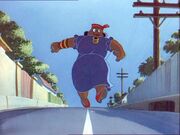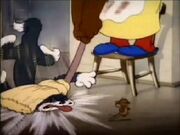Mammy Two Shoes (also known as Mammy, Mammy Two-Shoes, Mrs. Two Shoes in Tom and Jerry Tales or Dinah in the 1940 Tom and Jerry comics), is a recurring character in MGM's Tom and Jerry cartoons. She is a heavy-set, wealthy, middle-aged African-American woman who often has to deal with the mayhem generated by the lead characters.
As a partially-seen character, she was famous for never showing her head (although it is briefly visible in Saturday Evening Puss and Part Time Pal). Mammy's appearances have often been edited out, dubbed, or re-animated as a slim white woman in later television showings, since her character is a mammy archetype now often regarded as racist. It was later revealed that her character was greatly inspired by Oscar-winning african-american actress and singer Hattie McDaniel, best known for playing "Mammy" in MGM and David O. Selznick's 1939 film.
A character very similar to Mammy Two Shoes had earlier been portrayed in the Disney Silly Symphonies shorts Three Orphan Kittens and More Kittens, as well as the Pluto short Pantry Pirate and the Figaro short Figaro and Cleo. A similar character Aunt Petunia the Mammy actually shows her face which (of course) resembles blackface in The Little Audrey Cartoon Series.
Appearance
With dark brown skin (later changed to a Caucasian color) she is distinguished by her usual, sleeveless dress with frills in the shoulders, a white apron with frills in the trim, old, yellow socks (often seen with some kind of suspender holding it up) and red slippers. The color of her attire often changes, but the pieces remain virtually the same. These colors are yellow, orange, green, blue and red. She is usually seen holding a broom or cooking.
She is of mid-stature with dark skin, slightly rotund with a large bust and thick hands.
Theatrical Tom and Jerry cartoons

Mammy Two Shoes, in a scene from The Tom.
Mammy first appeared in Puss Gets the Boot, the first Tom and Jerry cartoon (except Tom was called "Jasper"). She always referred to Tom as his given name Thomas and almost always used "is" in conjunction with a pronoun ("is you" and "I is"). The character went on to make many appearances through 1952's Push-Button Kitty. William Hanna and Joseph Barbera initially portrayed Mammy as the maid of the house, with the real owners unknown to us. Later, Hanna and Barbera seemed to suggest, through dialogue and occasional behavior, that the house was Mammy's own.
Mammy was originally voiced by well-known African-American character actress Lillian Randolph. In the 1960s, the MGM animation cartoon, by then under the supervision of Chuck Jones, created censored versions of the Tom & Jerry cartoons featuring Mammy for television. These versions used rotoscoping techniques to replace Mammy on-screen with a thin white woman, and the voice on the soundtracks was replaced by an Irish-accented voice performed by white actress June Foray. The original versions of the cartoons were reinstated when Turner Broadcasting acquired ownership of the Tom & Jerry property. But in 1992, the cartoons featuring Mammy were edited again; this time, to replace Lillian Randolph's voice with that of Thea Vidale, whose dialogue was redone to remove the Mammy character's use of potentially offensive dialect. These versions of the cartoons are aired to this day on Turner's Cartoon Network-related cable channels, and have turned up on DVD as well. However, some European TV showings of these cartoons, especially the UK, retain Randolph's original voice. The Region 2 Complete Collectors Edition DVD boxset has Vidale's voice on the first DVD and Randolph in a number of the episodes after that (such as A Mouse in the House and Mouse Cleaning).
Replacement characters for Mammy

The American version of Mammy Two Shoes.
From 1954's Pet Peeve, Mammy disappeared from Tom and Jerry; the owners of the animals' house became a young, white, middle-class couple named Joan and George, and starting with 1955's The Flying Sorceress, the audience was able to see these owners' heads.
In 1961, when Rembrandt Films began producing Tom and Jerry shorts, the owner of the house became a corpulent white man. The character was designed by Gene Deitch, who recycled the design from his Terrytoons character Clint Clobber.[2] This new owner, whose face would turn bright red, and often derived great glee in doing so, was more graphically brutal in punishing Tom's mistakes as compared to Mammy Two Shoes, such as beating and thrashing Tom repeatedly, searing his face with a grill and forcing Tom to drink an entire carbonated beverage. "Clobber" (for want of a better name) was introduced in Down and Outing as a fisherman who owned Tom as well as their house. "Clobber" later appeared in High Steaks as a chef, and Sorry Safari as a hunter before being dropped.
Later, Tom's owner varied, with a housewife similar to the re-edited Mammy appearing in the later Deitch short Buddies Thicker Than Water and the direct-to-DVD film Tom and Jerry: The Fast and the Furry.
Tom and Jerry Tales and Mammy's modern return
In the modern Tom and Jerry Tales a redesigned Mammy has appeared, debuting in the short Ho Ho Horrors and turning up again later on. Though keeping her buxom, overweight build, tough personality, Southern accent and tendency to call Tom "Thomas," Mammy's skin tone has changed to Caucasian, presumably to avoid any possible controversy. Several photos on a mantle in Ho Ho Horrors also imply that Mammy now has a family (a man and a boy, also shown only as legs and partial torsos), though they have yet to appear in actual animation. In the short Power Tom the story casts Mammy as a superheroine called Power Gal, though it's only for this one cartoon.
In the new shorts, the now-Caucasian Mammy is explicitly called "Mrs. Two-Shoes".
Featured shorts
Tom and Jerry
- Puss Gets the Boot (1940)
- The Midnight Snack (1941)
- Fraidy Cat (cameo) (1942)
- Dog Trouble (cameo) (1942)
- Puss N' Toots (cameo) (1942)
- The Lonesome Mouse (1943)
- The Mouse Comes to Dinner (cameo) (1945)
- Part Time Pal (1947)
- A Mouse in the House (1947)
- Old Rockin' Chair Tom (1948)
- Mouse Cleaning (1948)
- Polka-Dot Puss (1949) (cameo)
- The Little Orphan (cameo) (1949)
- Saturday Evening Puss (1950)
- The Framed Cat (cameo) (1950)
- Casanova Cat (cameo) (1951)
- Sleepy-Time Tom (1951)
- Nit-Witty Kitty (1951)
- Triplet Trouble (1952)
- Push-Button Kitty (1952)
Tom and Jerry Tales (as Mrs. Two Shoes)
- Prehisterics
- Ho Ho Horrors (cameo)
- Tin Cat of Tomorrow
- Power Tom
- Cat Show Catastrophe (cameo)
- Adventures in Penguin Sitting
- Invasion of the Body Slammers (cameo)
- Summer Squashing
- Little Big Mouse
- You're Lion
- Monkey Chow
- Game of Mouse & Cat
- The Cat Whisperer
Major appearances
- The Lonesome Mouse - She's tricked by Tom's and Jerry's truce.
- Part Time Pal - She is tormented by a drunk Tom.
- Old Rockin' Chair Tom - She takes a cat named Lightning.
- Sleepy-Time Tom - She keeps an eye on Tom if he's sleeping on the job.
- Push-Button Kitty - She orders a robocat called Mechano.
- Tin Cat of Tomorrow - She orders a robocat called Verminator 7000.
- Power Tom - She disguises herself as Power Gal to save Tom and Jerry from Butch, Lightning and Topsy in a robbery.
Voice actresses of Mammy Two Shoes
- Lillian Randolph: 1940 - 1952
- Thea Vidale: (dubbed versions; uncredited)
- June Foray: Mammy as a thin white young woman.
- Nicole Oliver: Tom and Jerry Tales
Date of Birth
- 25 May, 1919
Gags
- Been constantly afraid of Jerry (or mices in general) and jumping to the nearest high spot such as a chair or the balcon.
- Pulling up the skirt, often pulling up, comically, many layers of skirts with distinct patterns.
- Easilly losing her temper with Tom's shenanigans.
Trivia
- In Tom and Jerry books, Mammy is often referred to as Cook.
- In 1940s Tom and Jerry comics, Mammy is usually named Dinah.
- The mammy character in Disney's Three Orphan Kittens is actually named Mammy Twoshoes (note spelling) in some licensed 1930s-1950s book adaptations.
- She was neither seen nor mentioned in Tom and Jerry: The Movie.
- In Push button kitty,Mammys skin is Gray.
